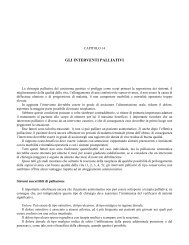Evidence-based medicine in the treatment of ... - Alfredo Garofalo
Evidence-based medicine in the treatment of ... - Alfredo Garofalo
Evidence-based medicine in the treatment of ... - Alfredo Garofalo
You also want an ePaper? Increase the reach of your titles
YUMPU automatically turns print PDFs into web optimized ePapers that Google loves.
Introduction<br />
In order to discuss <strong>the</strong> rational for <strong>the</strong> <strong>treatment</strong> <strong>of</strong> peritoneal surface<br />
malignancies it is imperative to def<strong>in</strong>e <strong>the</strong> problem, its magnitude, and understand its<br />
underly<strong>in</strong>g biology and pathophysiology.<br />
Peritoneal carc<strong>in</strong>omatosis (PC) is def<strong>in</strong>ed as <strong>the</strong> spread and implementation <strong>of</strong><br />
cancer cells <strong>in</strong> <strong>the</strong> peritoneal cavity result<strong>in</strong>g <strong>in</strong> malignant tissue deposits <strong>in</strong>volv<strong>in</strong>g<br />
parietal peritoneum surfaces or <strong>the</strong> visceral peritoneum l<strong>in</strong><strong>in</strong>g abdom<strong>in</strong>al and pelvic<br />
organs. Peritoneal carc<strong>in</strong>omatosis may be associated with accumulation <strong>of</strong> fluid <strong>in</strong> <strong>the</strong><br />
peritoneal cavity conta<strong>in</strong><strong>in</strong>g cancer cells, a condition known as malignant ascitis<br />
(MA).<br />
Primary neoplastic diseases <strong>of</strong> <strong>the</strong> peritoneum are rare and <strong>in</strong>clude peritoneal<br />
meso<strong>the</strong>lioma and primary peritoneal carc<strong>in</strong>oma. However, Peritoneal metastasis<br />
orig<strong>in</strong>at<strong>in</strong>g from colorectal carc<strong>in</strong>oma, ovarian carc<strong>in</strong>oma, gastric carc<strong>in</strong>oma,<br />
pancreatic carc<strong>in</strong>oma, and appendiceal carc<strong>in</strong>oma are more common [1]. Peritoneal<br />
surface malignancies (PSM) can present <strong>in</strong> <strong>the</strong> form <strong>of</strong> MA, multiple small tumor<br />
nodules, tumor masses <strong>in</strong> various sizes, layers <strong>of</strong> tumor tissue envelop<strong>in</strong>g peritoneal<br />
surfaces and organs, or muc<strong>in</strong> deposits, a condition known as pseudomyxomaperitonei<br />
(PMP).<br />
Pathophysiology<br />
The peritoneum is a th<strong>in</strong> layer <strong>of</strong> meso<strong>the</strong>lial cells supported by a network <strong>of</strong><br />
lymphatics and blood vessels. The pathophysiology and <strong>the</strong> molecular mechanisms<br />
underly<strong>in</strong>g <strong>the</strong> formation <strong>of</strong> PC are generally unknown. Metastatic tumor deposits<br />
spread with<strong>in</strong> <strong>the</strong> peritoneal cavity by a different and unrelated mechanism compared<br />
to <strong>the</strong> hematogenous spread <strong>of</strong> malignant diseases result<strong>in</strong>g <strong>in</strong> visceral metastasis or<br />
lymphatic spread <strong>of</strong> tumor cells result<strong>in</strong>g <strong>in</strong> regional lymph node metastasis. Several<br />
<strong>the</strong>ories were proposed to expla<strong>in</strong> <strong>the</strong> formation <strong>of</strong> PC [2].<br />
A "tumor rupture" physical <strong>the</strong>ory was proposed by several <strong>in</strong>vestigators.<br />
Accord<strong>in</strong>g to <strong>the</strong> "tumor rupture" <strong>the</strong>ory, a tumor <strong>of</strong> gastro<strong>in</strong>test<strong>in</strong>al or gynecological<br />
orig<strong>in</strong> <strong>in</strong>filtrat<strong>in</strong>g <strong>the</strong> serosal layer can exfoliate neoplastic cells <strong>in</strong>to <strong>the</strong> peritoneal<br />
cavity , result<strong>in</strong>g <strong>in</strong> PC; this process can be made easier by <strong>the</strong> surgical manipulation.<br />
[3,4]. Although this <strong>the</strong>ory may applied to some tumors, such as ruptured<br />
gastro<strong>in</strong>test<strong>in</strong>al stromal tumors (GIST) or o<strong>the</strong>r large solid tumors, it is very difficult<br />
to expla<strong>in</strong> how low rectal cancers with no direct communication to <strong>the</strong> peritoneal<br />
cavity can still result <strong>in</strong> PC. Also <strong>the</strong> observation that <strong>the</strong> <strong>in</strong>cidence <strong>of</strong> PC follow<strong>in</strong>g<br />
perforated adenocarc<strong>in</strong>oma <strong>of</strong> <strong>the</strong> colon is not significantly different than <strong>the</strong><br />
<strong>in</strong>cidence <strong>of</strong> PC follow<strong>in</strong>g non-perforat<strong>in</strong>g tumors contradicts this <strong>the</strong>ory . Exfoliation<br />
<strong>of</strong> cancer cells from a tumor would create a random pattern <strong>of</strong> PC. However, <strong>in</strong> most<br />
cases <strong>the</strong> pattern <strong>of</strong> PC spread is predictable [5].<br />
Muc<strong>in</strong> production is <strong>the</strong> hallmark <strong>of</strong> many secondary PSMs. Extracellular or<br />
<strong>in</strong>tracellular muc<strong>in</strong> secretion by cancer cells is associated with higher <strong>in</strong>cidence <strong>of</strong><br />
peritoneal spread. These observations are <strong>the</strong> basis <strong>of</strong> <strong>the</strong> "secretion <strong>the</strong>ory" which<br />
suggests that <strong>the</strong> peritoneal cavity is a hostile environment for cancer cells and acts as<br />
a barrier for systemic cancer spread. However, secretion <strong>of</strong> growth factors, nutritional<br />
factors, or o<strong>the</strong>r substances alone or embedded <strong>in</strong> muc<strong>in</strong>ous substance by <strong>the</strong> tumor



